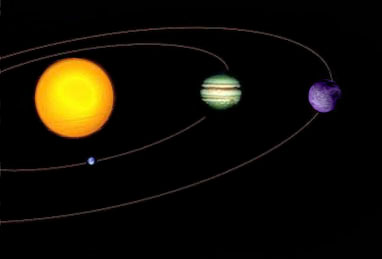Introduction
A lot of extrasolar planets were found and the numbers increase, one can not find
Earth-sized planets yet. Today we have only observational evidence of extrasolar planets of 7 earth masses
(Gliese 876d) and larger. The size of such planets is too large for the formation of life
and only a few of these planets lie in the 'Habitable Zone' (HZ). The HZ is defined as a
region
around a star, where the radiation for a earh-like planet is such that the planet
can maintain liquid water on the surface and a stable atmosphere.
Therefore we are looking for new possible dynamical configurations where a habitable
planet may host life.
There are four possible configurations for terrestrial like planets:

Type 1: a gas giant (GG) is very close to the central star
thus a terrestrial planet (TP) could exist with a stable
orbit in the HZ.
Type 2: when a GG moves far away from the central
star (like Jupiter), then stable low eccentric orbits for
TPs can exist inside the orbit of the giant planet.
Type 3: when a GG itself moves in the HZ, a terrestriallike
satellite (like e.g. Europa in the system of Jupiter)
could have a stable orbit (see also Domingos, Winter &
Yokoyama 2006).
Type 4: when a GG itself moves in the HZ, a Trojan-like (short introduction
about Trojan asteroids)
TP may move in a stable orbit around the Lagrangian
equilibrium points L4 or L5.
|
















